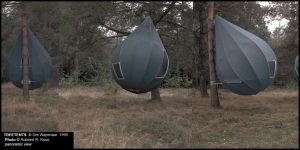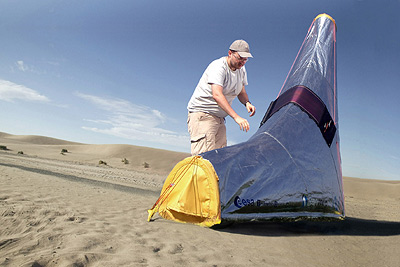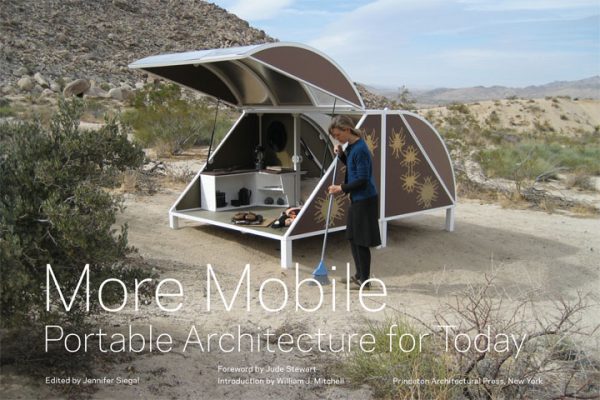Editor: Jennifer Siegal (Princeton Architectural Press, 2008)
More Mobile is the little book that roared. About the size of a stack of old 6”x 9” photos (remember those), this modest 145-page book could’ve been much bigger, but then it itself wouldn’t had been very ‘mobile’, representing the inside joke which is very much characteristic of the work found between its covers.
Chocked full of high-resolution colour images of the examples of transient design—tents, clothing, street carts, as well as Andrea Zittels’ rural pavilions—this literary homunculus is not just eye candy. Other highlights include the work of Horden Cherry Lee Architects and Atelier Bow-Wow, as well as the young Australian designer Andrew Maynard, whose whimsical yet elegant BOB provides the book’s most literal definition of ‘mobile living’.
The title of the book is not what I first expected, that is, an anthology of mobile design above and beyond the typical tent or trailer. It is in fact a sequel to Mobile (2002), in which Jennifer Siegal introduced the then frontline of mobile designers, some of whom make a reappearance in this showing. Jude Stuart, whose writing credits include Metropolis and I.D., provides a forward to the book, examining the present guises of mobility and their long and short histories, from the Bedouin tent to the airstream trailer, from Shigeru Ban’s paper pavilions to Melinda Stokes ergonomic clothing.
Australian writer William J. Mitchell, who passed away two years after the publication of this book and the once head of the Program of Media Arts and Sciences at MIT, provides a short essay as an introduction to the book: “A House is a Robot for Living In”, updating Le Corbusier’s notion of houses as ‘machines for living in’. Among other essays and books he’s authored, Me++ (2003) and Placing Words (2005) are the real introduction to this book, as they are acclamations of the new paradigm where our present digital age is laid atop all of western history. How the flesh meets the machine/computer/robot has consistently been the stuff of Mitchell’s writing, his illumination like that of John Ruskin writing about the death of the Arts and Craft era at the hands of the assembly line, and not unlike Walter Benjamin’s Work of Art in the Age of Mechanical Reproduction.
Mitchell’s introduction to the dozen design firms appearing within More Mobile provide an important frame for the now; a current commentary of humanity’s age old preoccupation with transience, and how new computer technology, which can vary from day to day now (where it was once year to year), has set the pace for our increased mobility. Most importantly, he makes us ponder what Ruskin or Benjamin would’ve made of the world wide web, or the cell phone.
Several years back, I happened upon an essay in a book called Placing Words, the final in a collection of essays by William Mitchell in which he also penned “Do We Still Need Skyscrapers?” and “After 9/11”. “Carriage Return” was the author’s nostalgia for riding the trains in his native Australia (and his admission that he probably learned to read his first words by reading the signs passing outside the windows of those trains), while the title of the essay itself refers to the now anachronistic act of a typewriter returning its carriage to begin the next (last) line of type on a page. It is a poetic eulogy for some of the old artifices of the writer, from the typewriter to riding the rails, and his realization that the world was changing in such a way that a new generation would quite possibly never know of any of these things.
As well, the collection of essays provided relevant commentary of some very unsettling historical events, from 9/11 and the tsunami, to the horrors of Abu Gharib. It’s his comic wit, however, that saves us, as in his recitation of an “Elegy for a G4” and “Less is More is Back”. Mitchell has a way of proclaiming new technology such that it is simultaneously objective and subjective, both empirical and romantic – and quite often comic.
Likewise is his “A House is a Robot for Living In” an enumeration of types and kinds of mobility, and how they are made possible by the different modes of movement of physical bodies. The essay builds up to a discussion of control systems, in which the complexities and hierarchies made possible by computers have allowed for buildings and various modes of transportation to become intelligent simply by the programs that are hard wired into them, i.e. robotics. A simple example of this would be how a building’s Heating Ventilation and Air Conditioning system is like an artificial lung. A more complex example would in turn be the life cycle of the building itself.
If I would offer one criticism of the book, it is the discontinuity that his essay is most concerned with types of mobility made possible by computers and robots, while much of the rest of the book is focused on types of physical mobility manifest in more urban settings—i.e. vehicles, living units, and installations—and in the ‘rough’, i.e. tents, trailers, and clothing. There is also a designer who specializes in stage design for high profile musical acts such as the Rolling Stones, somewhat out of sorts with Mitchell’s discussion of complex systems of robotics.
Notwithstanding, Mitchell’s essay is succinct in its timeliness, and appropriate as the point of departure for the book. The bulk of the book presents the designers and their designs, oscillating back and forth between the ephemeral and practical. As there first appeared no order to their presentation, I imagined a logic which proceeded from nomadism as a performing art, to actual mobile habitation, in this case from the clothing of Studio-Orta to the prefab homes of the Office of Mobile Design, founded by the editor herself. In between, seems an evolution of mobility—from clothes and tents to trailers and shipping containers, from carts and module housing complexes to a single-family mobile home.
Jennifer Siegal has assembled an unusual crosscut of artists, designers, architects, and engineers, whose pioneering spirit is reminiscent of Buckminster Fuller and Archigram. The first three designers/artists I would classify in the ‘performative’ realm, as while they are practical, their utility is secondary to their communication, which in itself contains some greater ideology. The clothing, which comprises only one of the many enterprises Studio-Orta produces, is as much a performing art as the tents of Dre Wapenaar, and the little trailer-like wagons of Andrea Zittel.
While this trio of artists have created utility out of clothing, tents, and trailers, the message they speak is much louder. For Studio-Orta, comprised of the two contemporary artists Lucy and Jorge Orta, it is an investigation of ‘the crucial themes of the world today: the community and the social link, dwelling and habitat, nomadism and mobility, sustainable development, ecology, and recycling.’ Most compelling is their small tent which also doubles as a hooded coat, along with their other ‘performative’ clothing—as though they were the tailors of human demonstration.

This segues nicely to the tents of Dutch designer Dre Wapenaar, who produced a series of teardrop shaped tents for a group protesting the destruction of their forests by their governments’ building of freeways. The tents, designed to hang in the trees, not only become the shelters for the protesters, but symbols of the occupation itself; an architecture of defiance, like the ships on the beaches of Troy.
Likewise are the installations of Andrea Vittel taking conventional artifices and making the stone stonier, as her A-Z Wagons situate themselves somewhere between a Bonair trailer and a room setting at IKEA. Her 2007 showing at the Vancouver Art Gallery featured her A-Z Compartment Units, which are the artists solution to creating more room within the modern notion of ‘living space’. In More Mobile, we also see her A-Z Wagon Station, a commune of ‘wagons’ in Joshua Tree, California.
The next trio of designers makes the transition from the primitive to a more technological definition of mobility. While Australian designer Andrew Maynard’s work is a distillation of present-day infrastructures—the car, the shipping container, the office cubicle—Swiss architect Andreas Vogler looks at ‘otherworldly’ infrastructures, like the robotic vehicles on Mars, or habitations that could be set up and occupied on the Moon. Rounding out the trio is Horden Cherry Lee Architects, who have gained some attention with their Carbon Neutral Micro-Compact Home and its iterations.
As previously mentioned, Andrew Maynard’s ‘BOB’ is an elegant hybrid of vehicle and shelter, but it was his ‘Design Pod’ which won him the Grand Prize in the Asia Pacific Design Awards in 2000. A ‘moveable workspace’, ‘Design Pod’ is an otherwise non-descript cylinder which opens up into a chair, desk, with several compartments and tables.
I was most intrigued by his ‘Corb V2.0’, which like Mitchell’s opening essay, posits what Le Corbusier may have thought of the present-day shipping container yard, by creating homes in modules (but not with the same dimensions as a real shipping container, which Maynard points out are terribly proportioned to living in). Each module would constantly move around via the mechanism of the shipping cranes—think Moshe Safdie’s ‘Habitat 67’, but imagine it constantly reshuffling itself like a deck of cards.

The work of Andreas Vogler in a similar way examines present day technologies and their infrastructures, with particular attention to more hostile environments, whether on a desert on the Earth, Moon, or Mars. His ‘DesertSeal’ is a practical solution to providing shelter in the desert, taking its inspiration from the curve of a camel’s neck, while his ‘MoonBaseTwo’ imagines a self-inflating shelter for otherworldly exploration.
Finally, the architectural studio comprised of Richard Horden, Stephen Cherry, and Billie Lee is committed ‘to developing highly efficient alternatives to existing architectural typologies based on technological advances.
They also represent the pivot of the book to its more architectural second half, from Atelier Bow-Wow to the Office of Mobile Design. Copenhagen based design firm N55 have continued the explorations of urban paradigm shifts, first pioneered by the likes of Archigram and the Metabolists. Based upon a cellular polyhedron living unit they call a micro dwelling, they have designed assemblies of these modules into honeycomb like space frame structures, for floating on or in the ocean, or perhaps even in the atmosphere. Part Moshe Safdie’s ‘Habitat’, part Buckminster Fuller, their living pods are not unlike pavilions at a world’s fair exposition.
Proceeding to the next collection of mobile designs and their designers, Atelier Bow-Wow’s oeuvre extends into the realm of pavilions, though their firm has started to realize much larger projects, in addition to the many single-family residences they have designed in Tokyo. Their clever design methodologies include exploration of the traditional Japanese street cart, the yatai, which they have designed to unfold into a mobile classroom or dining table the length of a stretch limousine.
Making an appearance in Vancouver as part of a lecture series in 2006, this design duo has been examining urban transience since they formed in 1992. As the editor points out, their playful and experimental installations have been shown the world over, from China and Korea to Brazil and Italy. Two books published by them in 2001 on Tokyo architecture more or less launched them into the realm of urban research, and their contributions to More Mobile are profound current statements of mobility in our modern age.
The inclusion of the work of the late Mark Fisher within the book, which at first perplexed me, led me to ponder the editor’s rationale, upon which I made an important discovery. Transience and mobility are in themselves very much a spectacle, as certainly seen in much of the examples in More Mobile, which almost always occurs within some larger social context. Whether it’s a set-up for a U2 show, an Expo, a campsite, or a demonstration, they are always a performance. And so the ‘architecture’ of Genesis and the Rolling Stones finds theirs place among the module housing of N55 and the street carts of Atelier Bow-Wow.
The final three entries in the book are perhaps the most emblematic of the ‘Prefab’ phenomenon and its continuing industry, as seen in the art gallery assembly by the Norwegian architecture firm of MMW, or the brilliant ‘container stores’ of NYC design studio LOT-EK, wherein the shipping containers become the stores themselves in which to merchandise the goods it carries.

The final design firm in the book, the Office of Mobile Design, was not surprisingly founded by the editor of the book herself. Founded in Los Angeles in 1998, Jennifer Siegal is ‘dedicated to the design and construction of modern, sustainable, and precision-built structures,’ and has championed her cause with the vehemence. As seen in her ‘Prefab Showhouse’, this playful twist on the mobile home employs the latest green strategies and materials, providing an interior environment rich in its details and materiality, and creating the ultimate example of ‘more mobile’ for the book.
Overall, More Mobile: Portable Architecture for Today is an entertaining and stimulating read, there is something here for designers, architects, urban planners, and researchers alike.
***
For more information on More Mobile, visit the Princeton Architectural Press website.
**
Sean Ruthen is an architect working, living, and writing in Vancouver.



One comment
Have a look at Jennifer Siegal’s books at the Toronto Public Library:
http://www.torontopubliclibrary.ca/search.jsp?N=4288945326
The Library also holds many of the works by William J. Mitchell:
http://www.torontopubliclibrary.ca/search.jsp?Nso=1&Ns=p_pub_date_sort&N=4292615394&view=grid&Erp=20
And we also have Mark Fisher’s book, Mark Fisher, Staged Architecture:
http://www.torontopubliclibrary.ca/search.jsp?N=4288708673